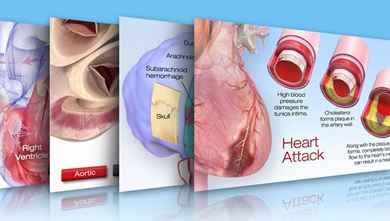Single Photon Emission Computed Tomography (SPECT)
What is a cardiac SPECT scan?
A SPECT scan of the heart is a noninvasive nuclear imaging test. It uses radioactive tracers that are injected into the blood to produce pictures of your heart. Doctors use SPECT to diagnose coronary artery disease and find out if a heart attack has occurred. SPECT (called a myocardial perfusion scan) can show how well blood is flowing to the heart and how well the heart is working.
Why do people have cardiac SPECT scans?
SPECT scans show areas of your heart that have low blood flow at rest or during exercise. This information helps your health care professional find out:
- If you have coronary artery disease.
- If you have areas of scar tissue from a heart attack.
- How well bypass surgery or other cardiac procedures worked.
- If you are having a heart attack and need more immediate tests such as a cardiac catheterization or percutaneous coronary intervention.
- If you are at risk of having a heart attack.
How does a SPECT scan work?
A small amount of radioactive tracer is injected into your bloodstream. Inside your body, the tracer produces a type of energy called gamma rays. A gamma camera picks up signals from the tracer, and a computer converts them into pictures of blood flow through your heart. Images of thin slices made all the way through the heart can be produced from all different directions and angles. These images are reviewed for the location and distribution of the tracer. Computer graphics can be used to create a 3-dimensional image of your heart from the thin-slice images.
SPECT scans can be done while you rest and during an exercise stress test (called a nuclear stress test). The stress test gives your health care professional a better idea of how well your heart handles work. If you can’t exercise, you may get a medicine to increase the blood flow in your heart as if you were exercising. This is called a chemical or pharmacologic stress test.
- If the test is normal during both exercise and rest, blood flow through the coronary arteries is normal.
- The test may show normal blood flow at rest but not after exercise. This may be due to a blockage in one or more coronary (heart) arteries. A blockage can create an area where little to no uptake of tracer can be seen.
- The test may be abnormal during both exercise and rest. In this case, the tracer won’t be visible in an area. This means that not enough blood is flowing to that area of the heart at any time.
- Lack of tracer may mean the cells in that area are dead from a prior heart attack. (They have become scar tissue.) Other imaging tests may be needed to assess this.
- By using specific radioactive tracers designed for this test, SPECT scans can also show how well your heart’s left ventricle (lower pumping chamber) is working.
What are the risks of a cardiac SPECT scan?
A cardiac SPECT scan is safe for most people. The amount of radiation is small, and your body will get rid of it through your kidneys in about 24 to 72 hours.
If you’re pregnant or think you might be pregnant, tell your health care professional. They may have you wait until after your pregnancy to have the scan if it's not urgent. If you’re a nursing mother, you should pump enough milk for a couple of days of feedings before your scan or feed your baby formula for one to two days after the scan.
How do I prepare for a cardiac SPECT scan?
- Tell your doctor about any medicines you take, including over-the-counter medicines, herbs and vitamins. They may ask you not to take them before the test.
- You may be asked not to have caffeine-containing food or drinks for 24 hours before your test. Caffeine can affect the test result.
- Don’t eat, and drink only water for 4 to 6 hours before your test.
- Wear loose-fitting clothing and comfortable shoes if you will have an exercise stress test.
What happens during a cardiac SPECT scan?
A doctor and nuclear medicine technologist usually perform the scan in a hospital or clinic using special equipment.
- The technician will place small disks or pads (electrodes) on your chest, arms and legs. The electrodes have wires that hook to a machine that records your electrocardiogram (ECG or EKG). The ECG keeps track of your heartbeat during the test and can be used to signal the camera when to take a picture.
- You’ll wear a cuff around your arm to track your blood pressure.
- The technician will put an intravenous line (IV) in your arm. The tracer will be injected through the IV.
- For a resting scan, you’ll lie on a table and a gamma camera will move around your chest and convert the tracer’s signals into pictures.
- For a nuclear stress test, you’ll either walk on a treadmill or ride on a stationary bicycle. Then you’ll again lie on the table for more pictures. If you can’t exercise, you’ll receive a medicine through the IV to increase the blood flow in your heart similar to what occurs during physical activity. The tests may take about an hour.
What happens after my SPECT scan?
- You can usually go back to your normal activities right away.
- Drink plenty of water for the next few days. This will help flush the radioactive material from your body.
- Make an appointment with your health care professional to discuss the test results and next steps.






